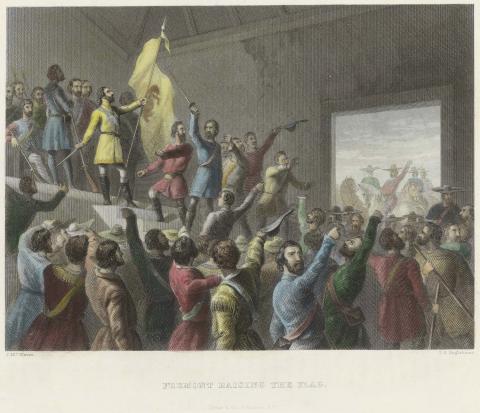Biographies | Images | Maps
When war broke out along the Rio Grande in May, 1846, the renowned explorer John C. Frémont was conducting his third expedition of the Far West for the War Department. Officially, Frémont had been sent to find the source of the Arkansas River. At the same time, he was a dedicated expansionist who, like his father-in-law Thomas Hart Benton, was committed to promoting the United States' larger territorial ambitions in the Far West. Prior to his departure, he and Benton had discussed at length the dangers of allowing California to fall into British hands. Although Benton had no authority to speak for the administration, Frémont would later claim to have been given confidential knowledge of the Polk administration's plans in the event of war with Mexico.
Arriving in the Sacramento Valley in early 1846, Frémont promptly sought to stir up patriotic enthusiasm among the American settlers in the area, promising them U.S. military protection should hostilities occur. In early May, 1846, somewhere near the Oregon-California border, Frémont met with a courier from the War Department, Lieutenant Archibald Gillespie. Although the contents of Gillespie's dispatches from Washington were never revealed, Frémont leapt to the wholly unfounded conclusion that a British invasion of California was imminent. In his memoirs written many years later, he recalled his determination to secure the Pacific coast for his country: "The time has come. England must not get a foothold. We must be first."
Meanwhile, Frémont's efforts to incite a rebellion were bearing fruit. On June 14, 1846, a small group of Anglo-Americans and other foreigners proclaimed their independence in the northern California town of Sonoma. Declaring the creation of a California Republic, they raised a crude flag over the village, bearing a single star and a grizzly bear. On June 23, Frémont arrived with sixty soldiers and took command in the name of the United States. An effort to put down the rebellion by Mexican troops was repulsed the following day at the Battle of Olompali. The growing army of rebellious settlers marched into San Francisco on July 1, 1846.
The U.S. Pacific squadron captured Monterey on July 7 and San Francisco three days later. Sloat's successor as commander of the Pacific squadron, Commodore Robert Stockton, acting jointly with Frémont, claimed California for the United States.

